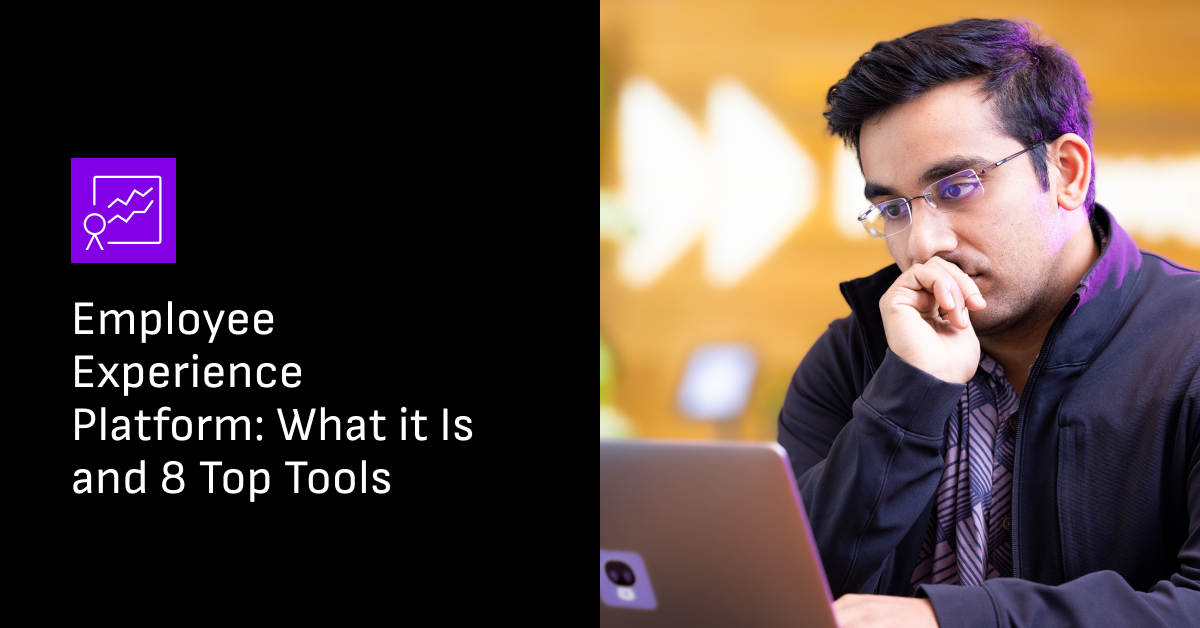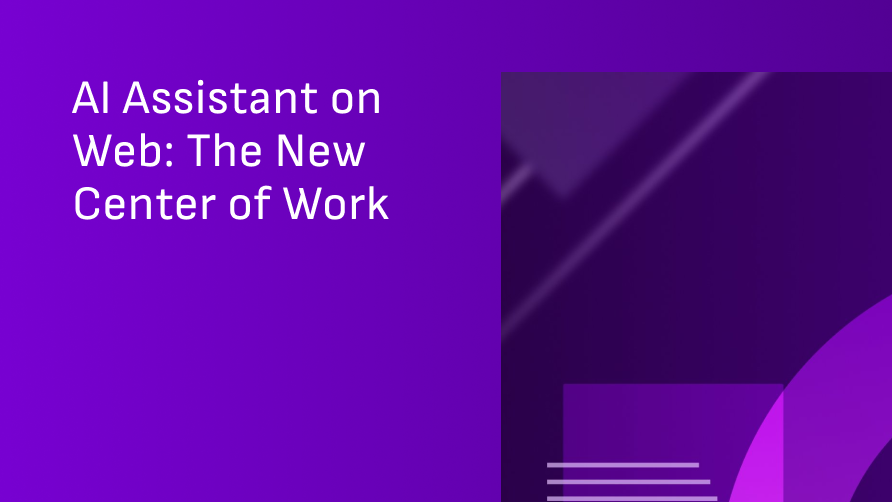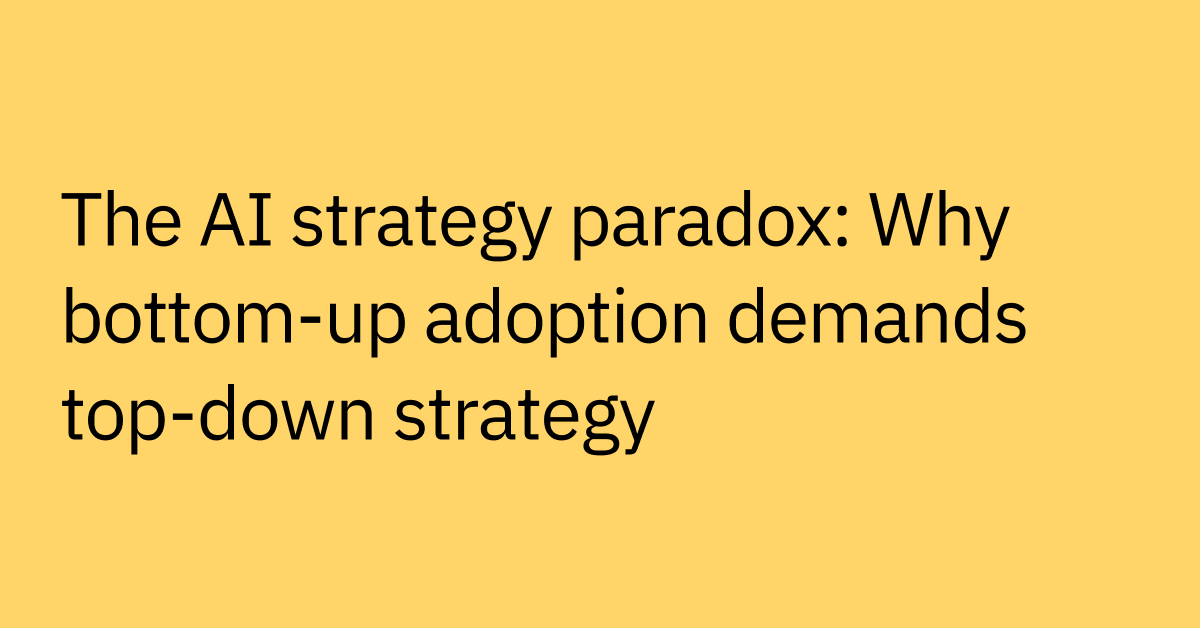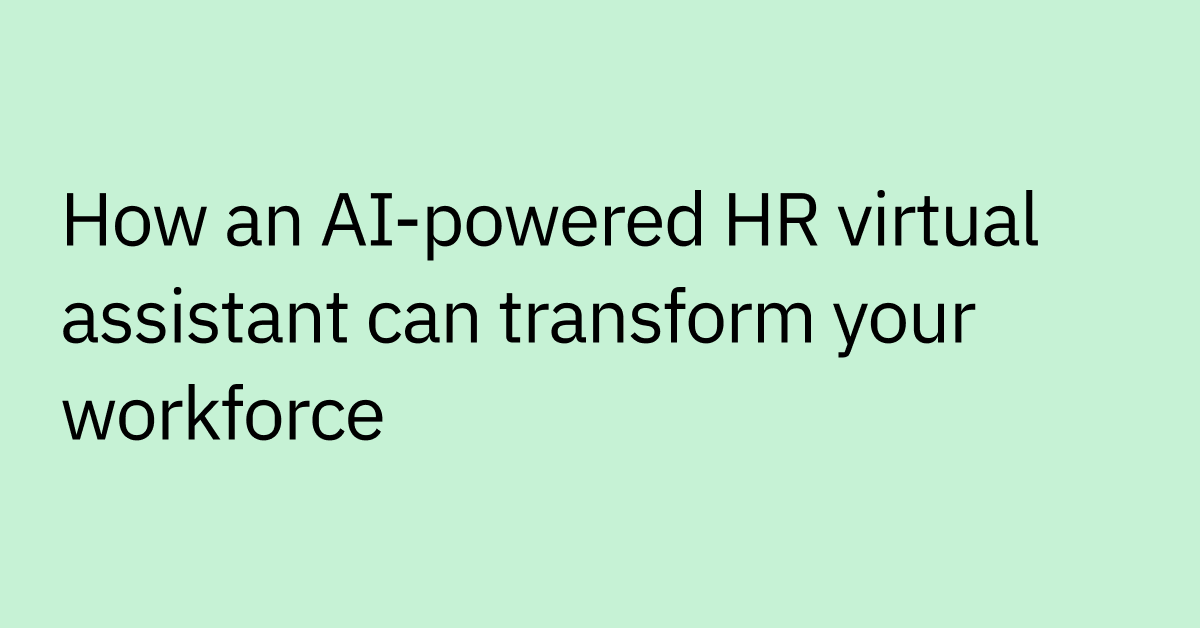Highlights
- An employee experience platform (EXPs) is a type of software that manages employee needs across HR, IT, and more, to enhance employee engagement, retention, and productivity
- Modern EXPs leverage AI to help leadersautomate routine support tasks, surface personalized content, and provide real-time insights into workforce sentiment.
- Core features include lifecycle automation, feedback and performance tracking, native integrations, and data-driven analytics for HR and IT teams.
- Leading platforms—including Moveworks—help centralize feedback, onboarding, and self-service to reduce friction across hybrid environments.
- Moveworks stands out with its agentic AI Assistant and Employee Experience Insights, providing 24/7 multilingual support and actionable visibility into workforce needs.
Enterprise growth may sound good on paper, but it doesn't come easily, especially for HR teams.
With hybrid environments, disjointed tools, and onboarding processes that break down under pressure, scaling can leave teams stretched thin and overwhelmed.
In fact, according to Gartner’s 2024 annual HR Priorities survey, 73% of HR leaders feel that management doesn't have the right tools, resources, or knowledge to navigate these shifts effectively.
Without solid communication and clear organization-wide visibility, it's hard to keep everyone aligned and working toward common goals. This can quickly lead to disconnected teams, poor departmental coordination, missed goals, and employee disengagement.
The great news is that there's a way to tackle these issues head-on.
By implementing a modern employee experience platform (EXP), you can break down communication barriers, streamline processes, and create a more connected and productive team, even as you scale.
At a glance: 8 enterprise employee experience solutions
Platform | Key Feature | Pricing Model | Ideal Use Case |
Moveworks | AI-powered agentic assistant for self-service support and task management | Quote-based | Enterprises looking to streamline workflows and provide intelligent self-service |
Rippling | All-in-one workforce management platform | Quote-based | Businesses that want to simplify HR processes and streamline IT infrastructure |
Workday Peakon | Automated pulse surveys and sentiment analysis | Quote-based | Companies with large, distributed teams that want to reduce attrition |
Qualtrics EmployeeXM | Captures employee sentiment and benchmarks against 300+ employee engagement metrics | Quote-based | Organizations improving employee engagement across specific technology investments |
Culture Amp | Detailed “People Science” analysis | Quote-based | Fast-growing companies wanting to support manager development and team growth |
Workvivo | Social-media-style company-wide engagement | Quote-based (minimum of $20,000 per month) | Businesses that want to create a strong social culture for remote and hybrid working teams |
Lattice | AI-powered goal setting and performance review analysis | Prices start at $10/seat/month | Mid-to-large organizations streamlining HR and enabling proactive team management |
Officevibe | Tools for employee feedback and engagement | Prices start at $5/user/month | Small to medium businesses establishing sustainable work culture and HR automations |
What is an employee experience platform?
An employee experience platform (EXP) is a type of software designed to support and enhance every stage of the employee journey, from onboarding to daily task execution to performance management.
Its primary purpose is to improve employee satisfaction, productivity, and retention for employees.
Meanwhile, it gives organizations greater visibility into common employee support issues and helps reduce manual HR tasks by centralizing communication, feedback, learning, and support tools into one integrated system.
Now, you might be thinking, “That sounds kind of like a company intranet or knowledge base.” And traditionally, you’d be right. But modern employee experience (EX) solutions go way beyond basic self-service and do more to accelarate HR workflows.
Today’s EXPs use advanced AI to deliver personalized, real-time support. They can:
- Surface relevant content based on employee intent
- Recommend customized development plans
- Automate routine tasks to streamline workflows
At the same time, they give leaders valuable insights into employees' sentiment and evolving needs, helping them create a more connected, engaged organization.
Benefits of implementing employee experience software
A modern EXP helps you manage and optimize every touchpoint your employee has with the company, from onboarding and training to daily support and task execution, leading to a more connected, productive, and resilient workforce
Here are four key benefits of implementing an EXP:
- Higher employee productivity
Organizations that prioritize employee experience see an 18% lift in productivity, thanks to streamlined workflows and reduced friction.
- Improved retention
According to Gallup, companies with strategic employee engagement programs experience up to 51% lower attrition rates.
- Workflow automation at scale
EX platforms free up HR teams and IT teams by automating routine support tasks — like answering common policy questions or provisioning access — so they can focus on strategic initiatives.
- Actionable insights into employee needs
These platforms collect real-time data on how employees interact with tools and services, helping leaders uncover common friction points and proactively improve the employee experience.
How to implement an employee experience solution
Of course, you can’t just drop an employee experience solution into your tech stack and expect immediate results. A successful implementation requires a clear strategy and a platform that aligns with your business’s specific needs and pain points.
Here’s how to get started.
1. Review your digital employee experience strategy
The first thing you'll want to focus on before implementing an EXP is getting all of your HR and IT stakeholders in the same room. Focus on identifying, from each group, the biggest operational challenges employees face across the organization.
This will help you design a digital experience (DEX) strategy that can help to solve them. Your DEX strategy should include:
- The tools, support channels and resources that employees rely on most
- Critical use cases you'll want to solve early, such as streamlining onboarding, creating a centralized knowledge base for HR policies, or providing on-demand IT support
- Implementation risks and how to address them
- A clear set of goals and key performance indicators (KPIs) you can track to measure success
2. Choose a platform with all the key features
Not all EXPs offer the same depth or breadth of functionality. Look for a solution that supports the entire employee journey — not just isolated tasks — and leverages automation to scale support.
As you assess different options, look for:
- A user-friendly interface that's easy to navigate regardless of skill level
- AI-driven automation that provides seamless lifecycle support for employee onboarding, training, and routine support
- Seamless collaboration and feedback tools — like pulse surveys or interactive polls — to keep teams aligned and leaders informed
- Built-in performance management functions to help employees set and reach personalized professional development goals
- Compatible integrations with your core systems, including HRIS, ITSM, and collaboration tools
- Highly visual analytics dashboards that surface actionable insights from employee usage patterns.
3. Roll out in stages and drive adoption
Work with your CIO, CHRO, and other key stakeholders to develop a phased implementation plan.
Start with one or two high-impact use cases and a limited pilot group to test functionality, gather feedback, and refine your rollout approach.
To drive adoption:
- Provide onboarding resources and hands-on training
- Communicate benefits clearly across teams
- Collect and act on employee feedback during rollout
- Share early wins and usage insights with leadership
When employees and stakeholders see value quickly, adoption scales faster — and your organization is better positioned to unlock the full potential of your EXP.
8 best employee experience platforms
There’s a huge range of features available in EXPs, so you’ll need to identify solutions that address specific gaps in your current system. Onboard the wrong platform, and you’ll likely create an even more fragmented program, leading to further disengagement, obscurity, and wasted investments.
1. Moveworks — Empower employees with AI-powered support at scale
Moveworks is a leading AI-powered enterprise solution designed to equip your entire workforce with intelligent, personalized support to help improve productivity, engagement, and efficiency.
Powered by advanced agentic AI technology, Moveworks provides 24/7 self-service in over 100 languages. Employees can get fast, accurate answers and automate tasks across apps — directly from tools they already use, like Slack and Microsoft Teams.
On the people team side, Employee Experience Insights (EXI) delivers actionable, real-time data, helping managers and HR leaders proactively address common pain points and keep teams engaged.
Key features:
- Powerful agentic AI Assistant that can directly execute complex employee requests
- Employee Experience Insights (EXI) extracts real-time data from ITSM platforms to help HR and IT teams identify and resolve common issues
- Retrieval-augmented generation (RAG) for secure, context-aware enterprise search results
- Workflow orchestration elements and native support for hundreds of third-party integrations
Ideal for: Medium to large global enterprises that want an AI-driven platform to help automate support, streamline workflows, and improve the employee experience at scale.
See how Moveworks can transform your employee experience.
2. Rippling — Actionable employee survey response insights
Rippling is an all-in-one workforce management solution that consolidates HR, IT, and finance-related processes, simplifying the management of employee data.
The platform helps extend the capabilities of traditional HRIS solutions by incorporating features like device management, global payroll services, and employer of record (EOR) services.
Key features:
- Streamlines the entire employee lifecycle, including paperwork, benefits enrollment, and shipping or recovering work equipment.
- Enables easy company-issued device management, including remote software installation and automated updates.
- Simplifies payroll and benefits administration for employees and contractors in over 140 countries.
Ideal for: Businesses wanting to refine and standardize HR processes across their teams while also providing IT departments with visibility and automation capabilities to gain better control over their enterprise infrastructure.
3. Workday Peakon — Real-time employee feedback to drive retention
Workday Peakon Employee Voice is designed to simplify employee feedback collection using anonymous pulse surveys. Instead of relying strictly on annual reviews, businesses can automate regular survey creation and scheduling to get real-time insights into their employee engagement levels from day one.
Using advanced AI-powered sentiment analysis and natural language processing (NLP), the platform helps businesses predict their employee attrition rates based on current and historical survey patterns.
Key features:
- Gathers employee input through pulse surveys for an up-to-the-minute view of workforce thoughts and opinions.
- Uses AI to analyze feedback, uncover hidden patterns, and interpret open-text comments to help prioritize management action.
- Enables feedback collection in over 60 languages across desktop, mobile, and collaboration platforms like Slack or Teams.
Ideal for: Larger distributed companies, particularly those with high turnover, where HR teams often struggle to understand the overall satisfaction of their workforce.
4. Qualtrics EmployeeXM — Optimize every employee touchpoint with real-time insights
Qualtrics EmployeeXM is an advanced EXP that focuses on improving every employee touchpoint through insights from surveys and passive listening.
The platform uses 300+ different benchmarks and metrics, like engagement levels and intent to stay, to provide management teams with actionable trends via personalized, easy-to-use employee dashboards.
Key features:
- Offers a 360-degree view of experiences while consolidating employee feedback across all digital channels.
- Continuously captures employee sentiment from company surveys, chat dialogues, and social media engagements.
- Alerts relevant management teams to new insights and recommended actions.
Ideal for: Larger companies that need a more effective, organization-wide solution to go beyond surveys and accurately gauge employee sentiment based on real experiences.
5. Culture Amp — Build high-performing cultures with actionable feedback
Culture Amp is designed to help you build a more positive company culture by simplifying the collection and analysis of employee feedback.
One of its key differentiators is its foundation in "People Science," which combines human psychology and data science to provide highly actionable insights regarding employee engagement, performance, and development.
Key features:
- Comprehensive employee engagement analysis tools, including over 40 survey templates.
- Employee retention data, industry benchmarking tools, and features for supporting managers through performance reviews and calibration efforts.
- Personalized insights for each employee with AI-powered coaching recommendations for professional development.
Ideal for: Fast-growing companies that want to empower managers and support healthier team development.
6. Workvivo — Connect and engage employees through social intranet
Workvivo is a social intranet platform built to increase employee engagement using intuitive, collaborative communication tools. The platform centralizes business comms into a social-media-style interface, with dynamic company news feeds that include likes, comments, and shares with other team members.
Workvivo focuses on bringing a more modernized touch to internal collaboration and helps transform dated company intranets into living, breathing employee communities.
Key features:
- Personalized social media feed where employees can get important updates or share achievements across departments.
- Powerful search function for fast, accurate information retrieval.
- Integrations with popular tools like Slack, Microsoft Teams, Zoom, Microsoft 365, and Google Workspace.
Ideal for: Businesses with remote or hybrid teams that want to create a strong social culture, regardless of where their employees work.
7. Lattice — Align performance, goals, and growth in one platform
Lattice is a people management platform that uses AI automation to streamline HR processes and enhance employee satisfaction through goal setting, performance reviews, and real-time analytics.
By integrating powerful AI agents across Lattice's extensive partner ecosystem, HR teams can boost their employee productivity levels, streamline their payroll processes, and manage real-time feedback all from one location.
Key features:
- Automated and highly customizable workflows for regular performance evaluations, including 360-degree feedback.
- Integrates goal setting directly into the performance management process to align individual, team, and company milestones.
- Dedicated development tools for personalized growth plans, skill tracking, and mapping career paths.
Ideal for: Mid-sized to large organizations that want to streamline core HR processes while providing managers with tools for proactive and progressive team management.
8. Officevibe — Boost engagement with easy, actionable team feedback
Officevibe is a cloud-based EXP that offers a suite of tools for gathering feedback and promoting open communication and collaboration among teams.
Businesses can track employee career progression, distribute engagement surveys, and manage performance reviews using Officevibe’s AI-powered data aggregation tools and custom process automation.
Key features:
- Customizable pulse surveys and an anonymous suggestion box to encourage honest communication from teams.
- Employee well-being features like guided meditations and mental health check-ins.
- Custom analytics dashboards that translate employee feedback into comprehensive reports with actionable recommendations.
Ideal for: Small to medium-sized businesses that are trying to establish a sustainable working culture for employees while providing helpful workflow automations for HR teams.
Deliver smarter support at every employee touchpoint
Whether employees need help understanding company policies, requesting IT support, or navigating a benefits issue, the right employee experience platform can help them feel heard, supported, and engaged — every day.
Moveworks AI Assistant and leading EXP capabilities empower your entire workforce with real-time, intelligent, AI-powered assistance whenever and wherever it's needed.
By connecting to all your enterprise apps and systems Moveworks helps eliminate unnecessary friction in daily workflows, automating a wide range of routine HR and IT-related tasks.
And with Moveworks, leaders gain clear visibility into employee issues, concerns, and engagement levels — so you can proactively improve the employee experience at scale.
See Moveworks in action — schedule your free demo today and discover how AI can simplify support and drive productivity.
Table of contents



